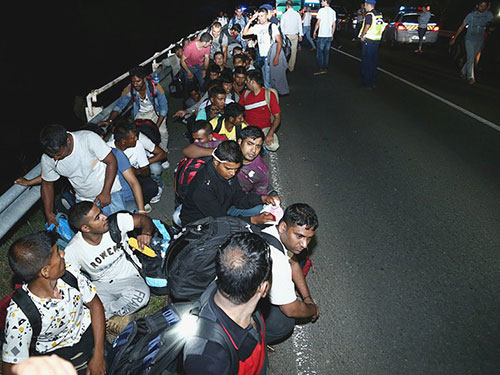Date: Fri, 30 Oct 2015 00:07:27 +0100
By Stephanie J. Silverman
The Syrian refugee crisis has finally grabbed the world’s attention and is testing the sustainability of the European Union and its common asylum adjudication procedures. Policymakers are struggling to find solutions from under a complex latticework of administering and securitizing refugee and immigration admissions policy.
This struggle is amplified by the revelation that the influx may represent only the tip of a much larger cohort. As president of the European Council Donald Tusk predicted at a recent EU leaders summit: ‘The greatest tide of refugees and migrants is yet to come.’ These future asylum seekers are not only from Syria but also from Iraq, Afghanistan, and other impoverished, violent, and at-war states.
The many signs of fracture within the EU revolve over how to allocate permanent residence rights. To be sure, this fracture should be contextualized within a larger global malaise wherein funding to support UNHCR and other aid efforts is insufficient. An average of almost 5,000 Syrians are fleeing into neighbouring countries every day. The majority of refugee hosting (86%) is shouldered by developing countries, including Turkey, Pakistan, and Lebanon. Nevertheless, the challenge posed by the Syrian, Afghan, and Iraqi asylum seekers coming to Greece, Italy, Hungary, and Macedonia to the European project has been severe.
Yet, the issue of how many people to take in – and where – is present as a live issue across the EU, and is resulting in inter-country spats. In September, an escalating borderlands row between Serbia and Croatia prompted Serbia’s foreign ministry to characterize Croatia’s measures as ‘discriminatory’; they ‘can only be compared with measures taken in the past, during the fascist Independent Croatia’, referring to the 1941 Nazi puppet state in Croatia, which sided with Nazi Germany. For his part, Croatia’s Prime Minister said Serbia’s behaviour was ‘not normal.’ Both states have now officially closed their territorial borders. Although initially demonstrating an unprecedented openness to welcoming Syrians, Germany has since suspended its commitments under the Schengen Agreement of an EU-wide border-free zone, for example through checking the papers of people coming in from Austria.
Nevertheless, and in spite of dissenting votes from Hungary, the Czech Republic, Slovakia, and Romania, the Justice and Home Affairs Council (JHA) decided on 22 September to relocate across the EU 120,000 people “in clear need of international protection” from Italy (15,600), Greece (50,400) and Hungary (54,000). Alongside this carrot comes a stick, of course. The stick is Tusk’s establishment of ‘hotspots’ to register and temporarily house incoming asylum seekers. Forecasted to be operational in November, the ‘hotspots’ will accommodate people until a refugee status decision can be taken ‘quickly’. There is a parallel aim of repatriating those whose asylum claims are refused. The hotspots will be located at the EU’s external borders. Staffing the ‘hotspots’, EU officers will be responsible for identifying and separating asylum seekers from ‘economic migrants.’
For a number of reasons, the Syrian and other asylum seekers are trying to avoid the already-established transit camps in Hungary. First, the conditions are said to be squalid. Second, the asylum seekers wish to preclude getting interned and having their journeys halted. And, thirdly, the asylum seekers do not want to be fingerprinted and thus forced by the Dublin Regulations to ask Hungary for asylum instead of the more prosperous, English-speaking, and community-networked countries of Western and Northern Europe.
The ‘hotspots’ could mark an improvement over these camps, and undoubtedly over sleeping rough in subzero temperatures and at the mercy of extortionist gangs and xenophobic crowds. Nevertheless, it is not right that the EU is offering asylum seekers only these options – detention in camps / hotspots, or sleeping rough. Further, this is a false ‘choice’ because the hotspots will not be optional. The vague description of the hotspots leaves open a number of questions without answers. For instance, how long are people expected to reside there? Can they leave without ‘volunteering’ for repatriation? Will they receive legal, holistic, and linguistic support in making their asylum claims? Can journalists, parliamentarians, NGO representatives, and other people visit?
The ‘hotspots’ are not a solution to the influx of people, the criminalization of their migrations, or the eroding solidarity amongst EU Member States. In fact, all they can provide is a stopgap measure to sidestep destruction of the faltering Europe-wide immigration and asylum adjudication system. Indeed, following the pattern common to detention measures, the emphasis here is on effective, speedy return of refused asylum seekers, not on humane treatment, legal and social counseling, and community engagement. Also viz. detention, the true costs of deprivations of liberty – particularly for traumatized people from war-torn regions – are not being totaled into the hotspots’ price tags.
As was the case with the US Administration when tens of thousands of Central American asylum seekers arrived in the summer of 2014, the resort to detention can be the go-to reaction amongst states receiving great numbers of asylum seekers in a relatively short period of time. However, as demonstrated in the court decision ordering the release of families from US detention, more careful thinking needs to be undertaken before turning to detention because of the harms it inflicts. Whether it’s labeled ‘camps’ or ‘hotspots’, a detention system can only ever be an interim measure to address transnational migration, and it is certainly not the appropriate response to the unprecedented movements of people to Europe from Africa and the Middle East.
